On the Seismic Performance of Autoclaved Aerated Concrete Self-Insulation Block Walls
Abstract
:1. Introduction
2. Experimental
2.1. Properties of AAC Self-Insulation Blocks and Mortars
2.2. Preparation of Wall Specimens
2.3. Seismic Test Method
3. Test Results and Discussion
3.1. Crack Distribution and Failure Pattern
3.2. Load-Displacement Hysteretic Curves and Featured Values
3.3. Stiffness Degeneration
3.4. Energy Dissipation
4. Prediction of Shear Resistance
5. Conclusions
- (1)
- A typical damage pattern with intersected slant cracks was seen on the AAC self-insulation block walls under seismic loads. The type of mortar joints had some influence on the slant crack distribution. More almost-vertical cracks appeared on the walls with vertical joints filled by mineral wool plates. The blocks on push/pull sides of the walls tended to be easily broken under higher vertical compressive stress at failure state.
- (2)
- The walls with thin-layer mortar joints had an entirely better seismic performance. The cracking resistance was about 13.1% higher with a displacement that was about 54.2% greater, in spite of lower ultimate capacity (about 4.5%) than the walls with self-insulation mortar joints. The cracking resistance and ultimate capacity of the walls with vertical joints filled by mineral wool plates were lowest with the worst displacement ability, which were about 80.9% and 85.1% of those of the walls with thin-layer mortar joints.
- (3)
- The integrality of the walls was weakened with the vertical joints filled by mineral wool plates. This led to the reduction of seismic performance of the walls in stiffness and energy dissipation. Compared to the walls with thin-layer mortar joints, the walls with vertical joints filled by mineral wool plates underwent a reduction of about 10–12% in terms of the energy dissipation factor and the equivalent viscous damping coefficient.
- (4)
- The vertical compressive stress had a certain impact on the seismic performance of the AAC self-insulation block walls. Under higher vertical compressive stress, the stiffness of the walls increased, and the energy dissipation decreased.
- (5)
- With rational shear strength of the block masonry along the mortar joint, the shear resistance of the AAC self-insulation block masonry walls can be predicted by the formulas specified in China code JGJ/T17 and Eurocode 6.
Author Contributions
Funding
Acknowledgments
Conflicts of Interest
References
- Autoclaved Aerated Concrete Block; Standards Press of China: Beijing, China, 2006.
- Bhosale, A.; Zade, N.P.; Davis, R.; Sarkar, P. Experimental Investigation of autoclaved aerated concrete masonry. J. Mater. Civ. Eng. 2019, 31, 04019109. [Google Scholar] [CrossRef]
- Artino, A.; Gianpiero Evola, G.; Margani, G.; Marino, E.M. Seismic and energy retrofifit of apartment buildings through autoclaved aerated concrete (AAC) blocks infill walls. Sustainability 2019, 11, 3939. [Google Scholar] [CrossRef] [Green Version]
- Ravichandran, S.S.; Klingner, R.E. Behavior of steel moment frames with autoclaved aerated concrete infills. ACI Struct. J. 2012, 109, 83–90. [Google Scholar]
- Sucuoglu, H.; Siddiqui, U.A. Pseudo-dynamic testing and analytical modeling of AAC infilled RC frames. J. Earthq. Eng. 2014, 18, 1281–1301. [Google Scholar] [CrossRef]
- Du, D.; Wang, S.; Li, W.; Xu, F.; Liu, W. Seismic Performance of the pre-fabricated steel frame infilled with AAC wall panels and their joint connection: Full-scale shaking table test. J. Earthq. Tsunami 2019, 13, 1940004. [Google Scholar] [CrossRef]
- Costa, A.A.; Penna, A.; Magenes, G. Seismic performance of autoclaved aerated concrete (AAC) masonry: From experimental testing of the in-plane capacity of walls to building response simulation. J. Earthq. Eng. 2011, 15, 1–31. [Google Scholar] [CrossRef]
- Rosti, A.; Penna, A.; Rota, M.; Magenes, G. In-plane cyclic response of low-density AAC URM walls. Mater. Struct. 2016, 49, 4785–4798. [Google Scholar] [CrossRef]
- Milanesi, R.R.; Morandi, P.; Magenes, G. Local effects on RC frames induced by AAC masonry infills through FEM simulation of in-plane tests. Bull. Earthq. Eng. 2018, 16, 4053–4080. [Google Scholar] [CrossRef]
- Binici, B.; Canbay, E.; Aldemir, A.; Demirel, I.O.; Uzgan, U.; Eryurtlu, Z.; Bulbul, K.; Yakut, A. Seismic behavior and improvement of autoclaved aerated concrete infill walls. Eng. Struct. 2019, 193, 68–81. [Google Scholar] [CrossRef]
- Penna, A.; Mandirola, M.; Rota, M.; Magenes, G. Experimental assessment of the in-plane lateral capacity of autoclaved aerated concrete (AAC) masonry walls with flat-truss bed-joint reinforcement. Constr. Build. Mater. 2015, 82, 155–166. [Google Scholar] [CrossRef]
- Tomaževič, M.; Gams, M. Shaking table study and modelling of seismic behavior of confined AAC masonry building. Bullet. Earthq. Eng. 2012, 10, 863–893. [Google Scholar] [CrossRef]
- Zhao, C.W.; Zhang, L.; Gao, L.Y.; Zhou, P.H.J. Experimental study on seismic performance of autoclaved aerated concrete block bearing walls. J. Shenyang Jianzhu Univ. (Nat. Sci.) 2009, 25, 426–432. [Google Scholar]
- Li, J.H.; Xue, Y.T.; Xiao, C.Z.; Chang, Z.Z.; Li, Z. Experimental study on seismic performance of full-scale RC frame infilled with autoclaved aerated concrete blocks. China Civ. Eng. J. 2015, 48, 12–18. [Google Scholar]
- Li, F.L.; Chen, G.L.; Zhang, Y.Y.; Hao, Y.C.; Si, Z. Fundamental properties and thermal transferability of masonry built by autoclaved aerated concrete self-insulation blocks. Materials 2020, 13, 1680. [Google Scholar] [CrossRef] [PubMed] [Green Version]
- Si, Z.K.; Zhang, D.L.; Chen, X.F. Experimental study on thin layer mortar formulation for self-insulation system. China Concr. Cem. Prod. 2016, 43, 61–65. [Google Scholar]
- Loganina, V.; Frolov, M.; Fediuk, R. Developed heat-insulating dry mortar mixes for the finishing of aerated concrete walls. Mag. Concr. Res. 2020, 1–14. [Google Scholar] [CrossRef]
- Standard for Test Method of Basic Mechanical Properties of Masonry; China Building Industry Press: Beijing, China, 2011; GB/T50129-2011.
- Zhao, S.B.; Yang, S.; Song, L.S.; Sun, L.; Song, C.X. Experimental study on thermal insulation properties of reinforced concrete composite wall. Appl. Mech. Mater. 2011, 99, 676–679. [Google Scholar] [CrossRef]
- Specification for Seismic Test of Buildings; China Building Industry Press: Beijing, China, 2015; JGJ/T101-2015.
- Technical Specification for Application of Autoclaved Aerated Concrete; China Building Industry Press: Beijing, China, 2010; JGJ/T17-2008.
- Code for Seismic Design of Buildings; China Building Industry Press: Beijing, China, 2010; GB50011-2010.
- Design of Masonry Structures, Part 1: General Rules for Reinforced and Unreinforced Masonry Structures; CEN: Brussels, Belgium, 2010; EN1996-1-1 Eurocode 6.
- Building Code Requirements and Specification for Masonry Structures; The Masonry Society: Boulder, CO, USA, 2011; TMS402-11/ACI530-11/ASCE5-11.
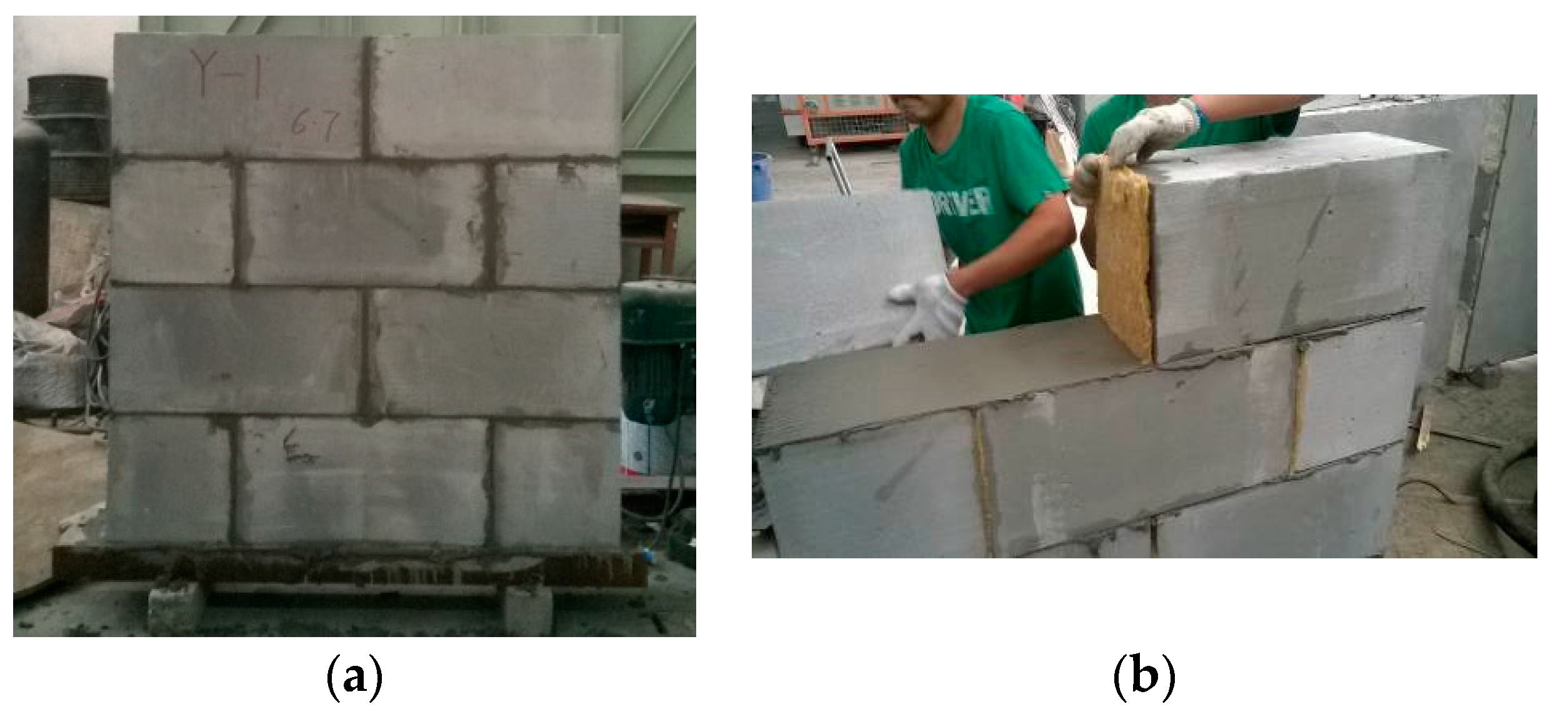

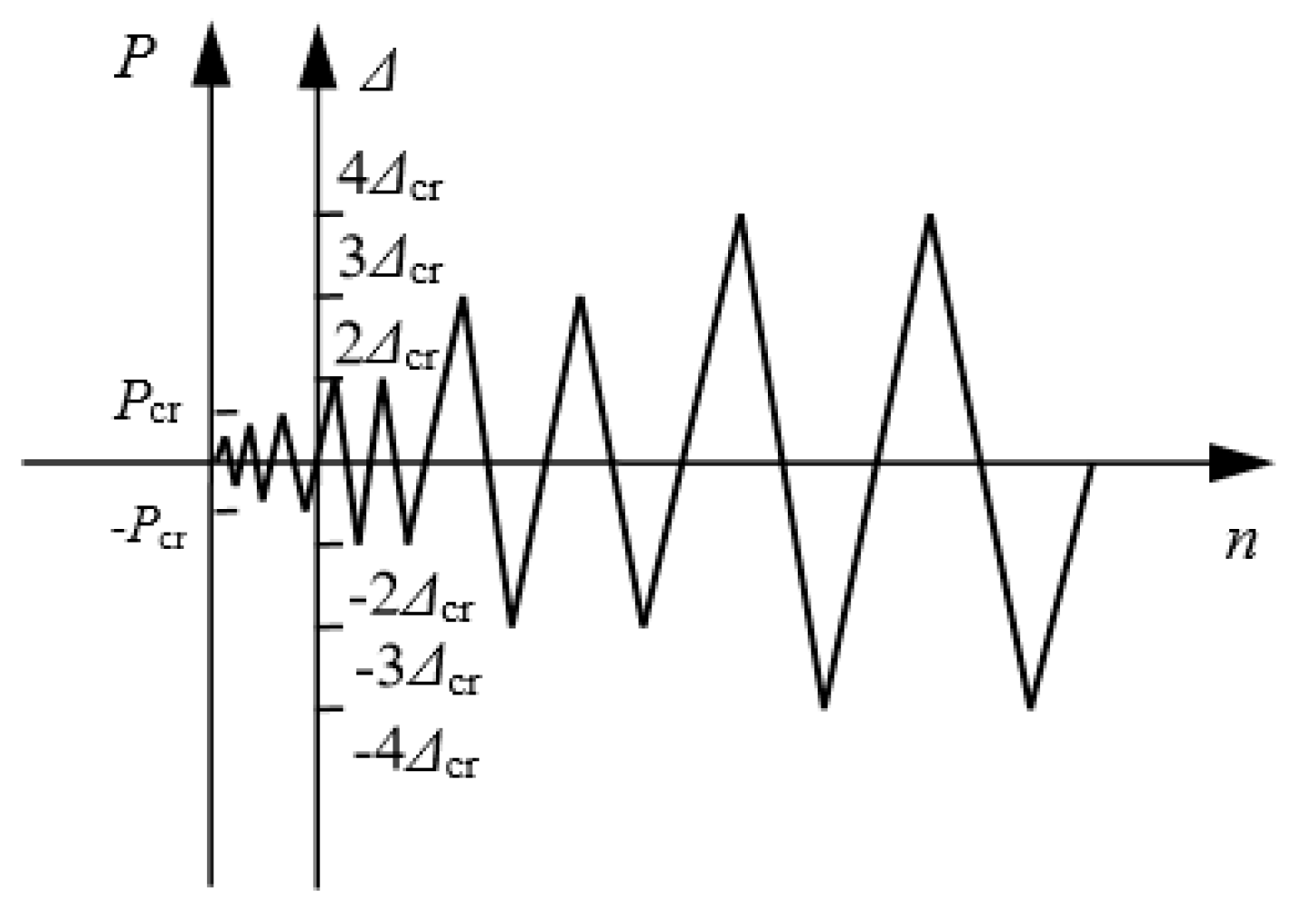
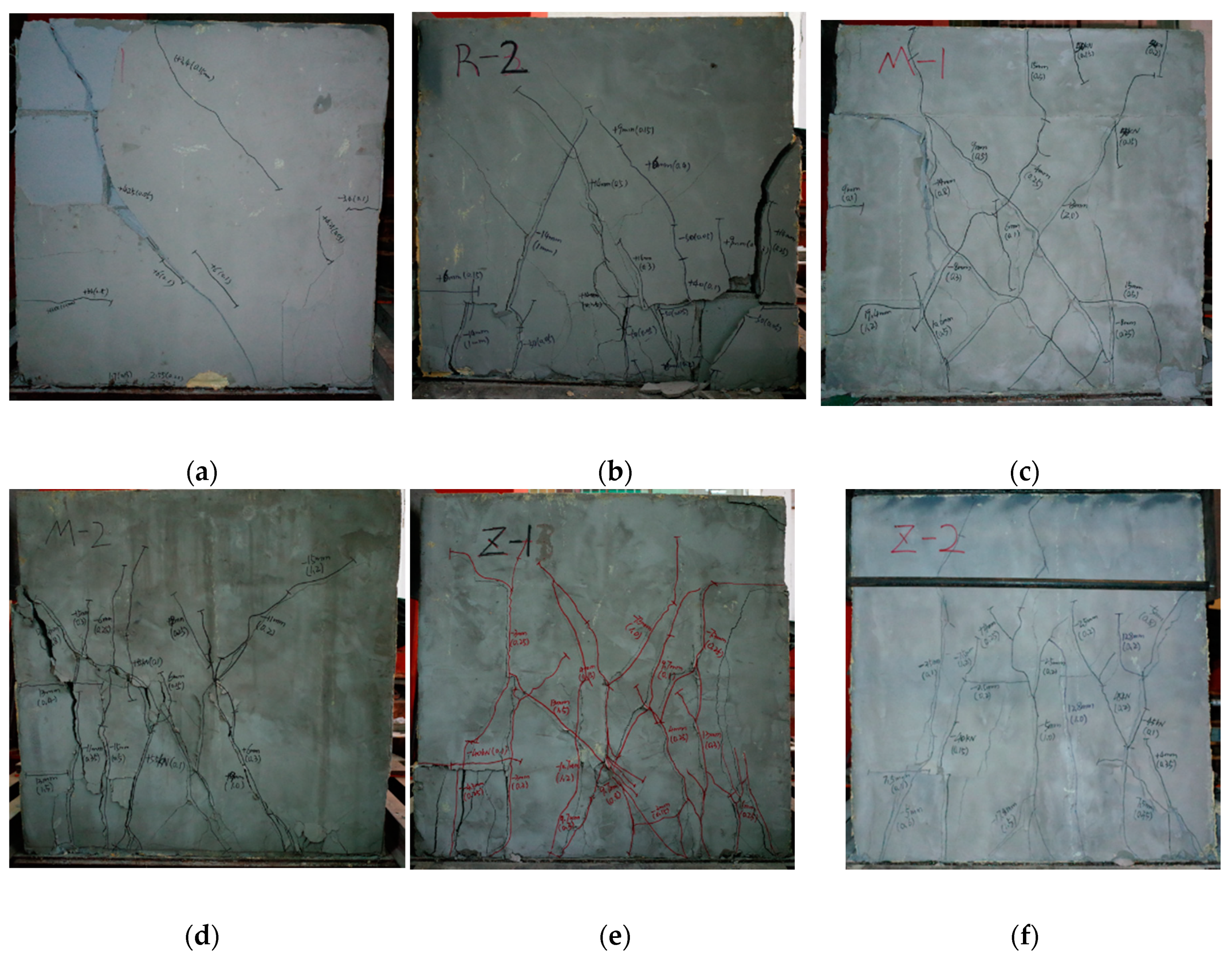
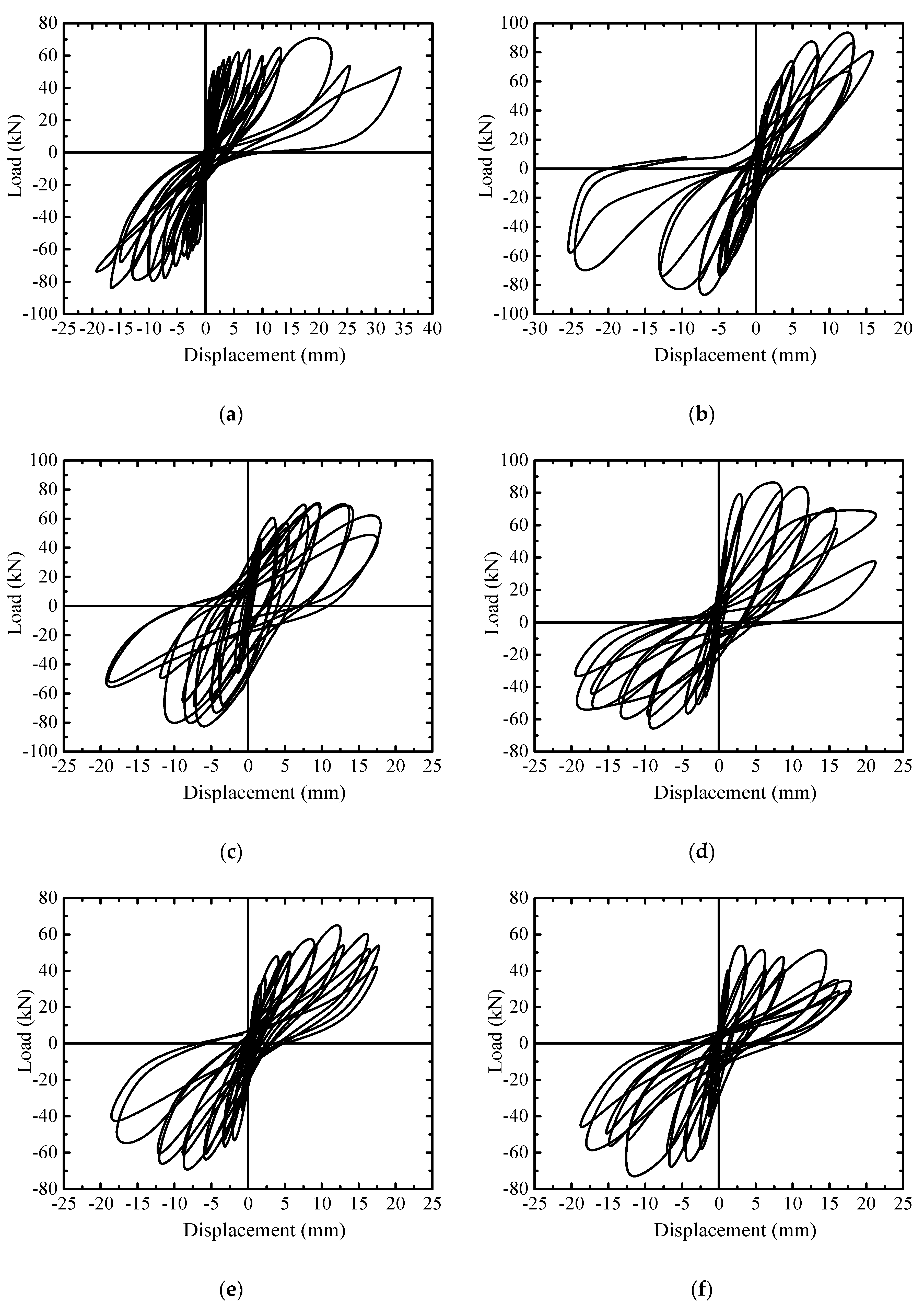
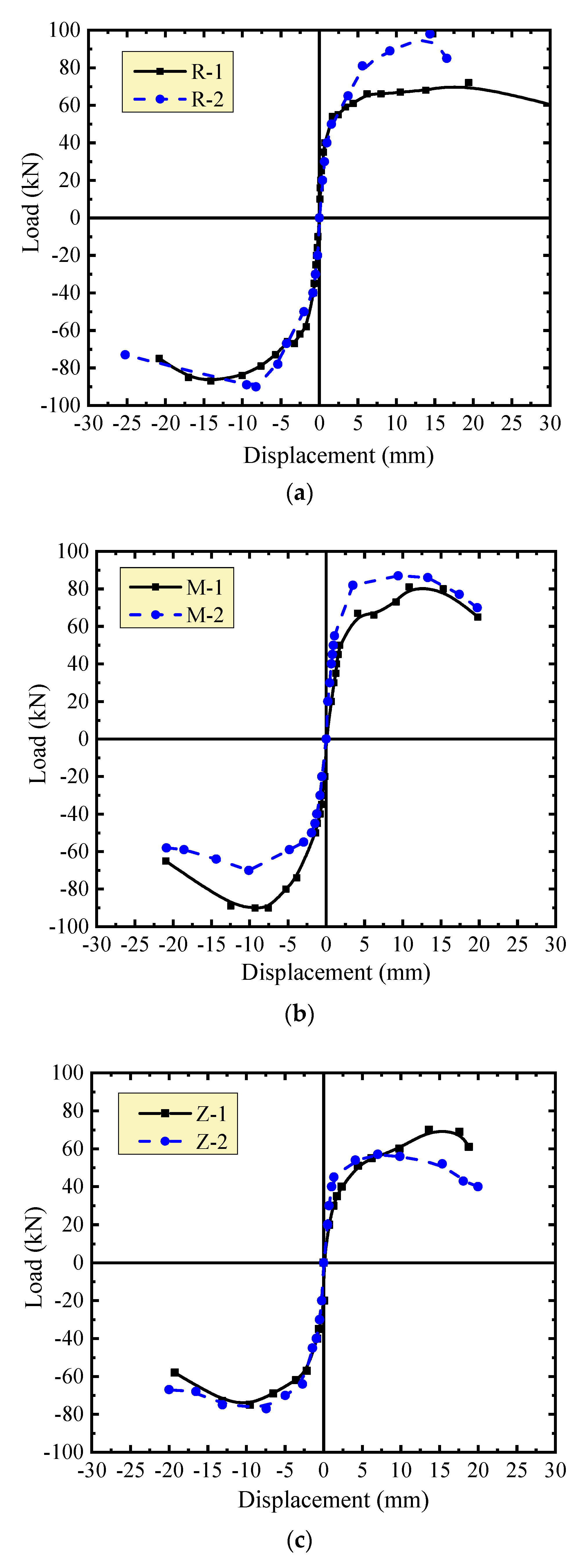
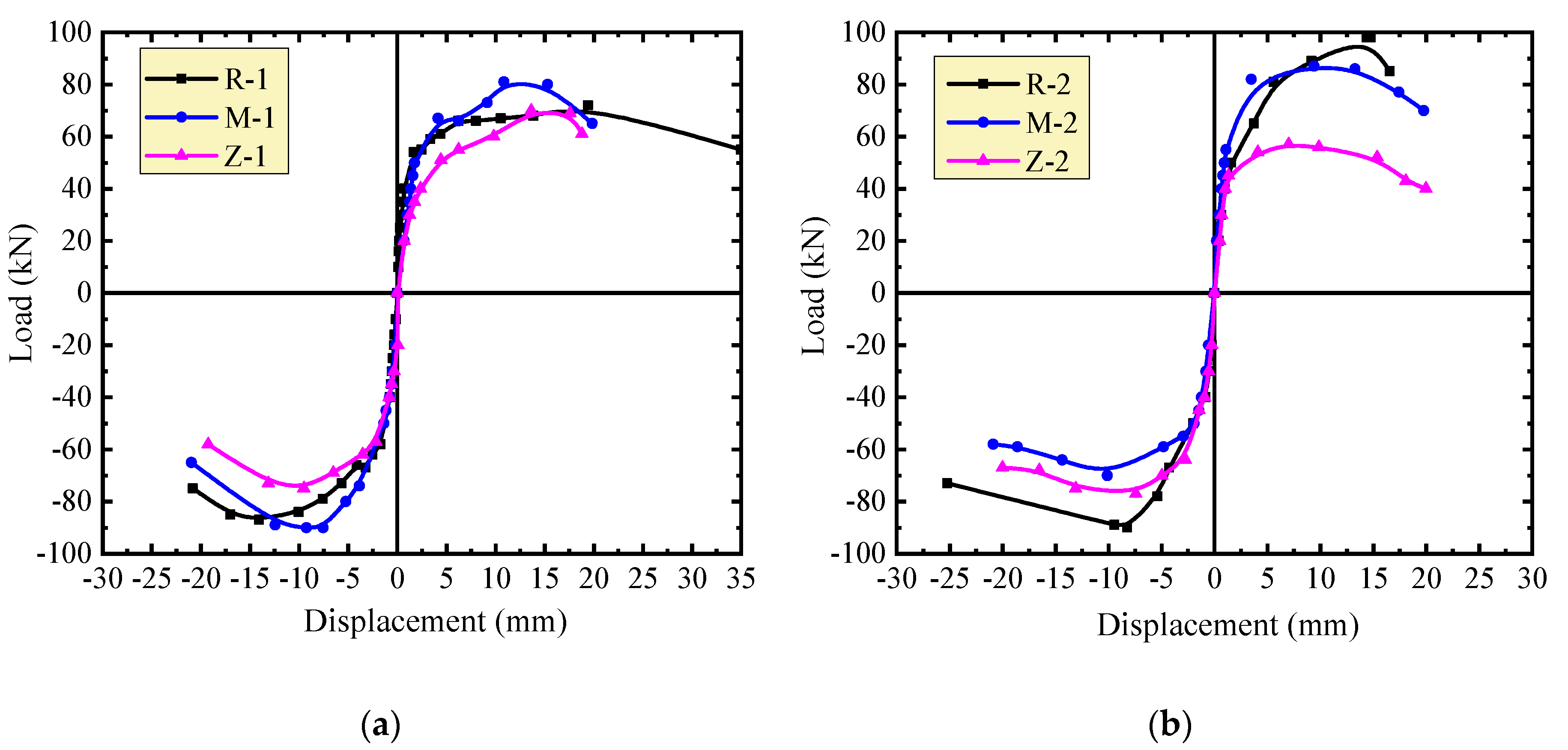
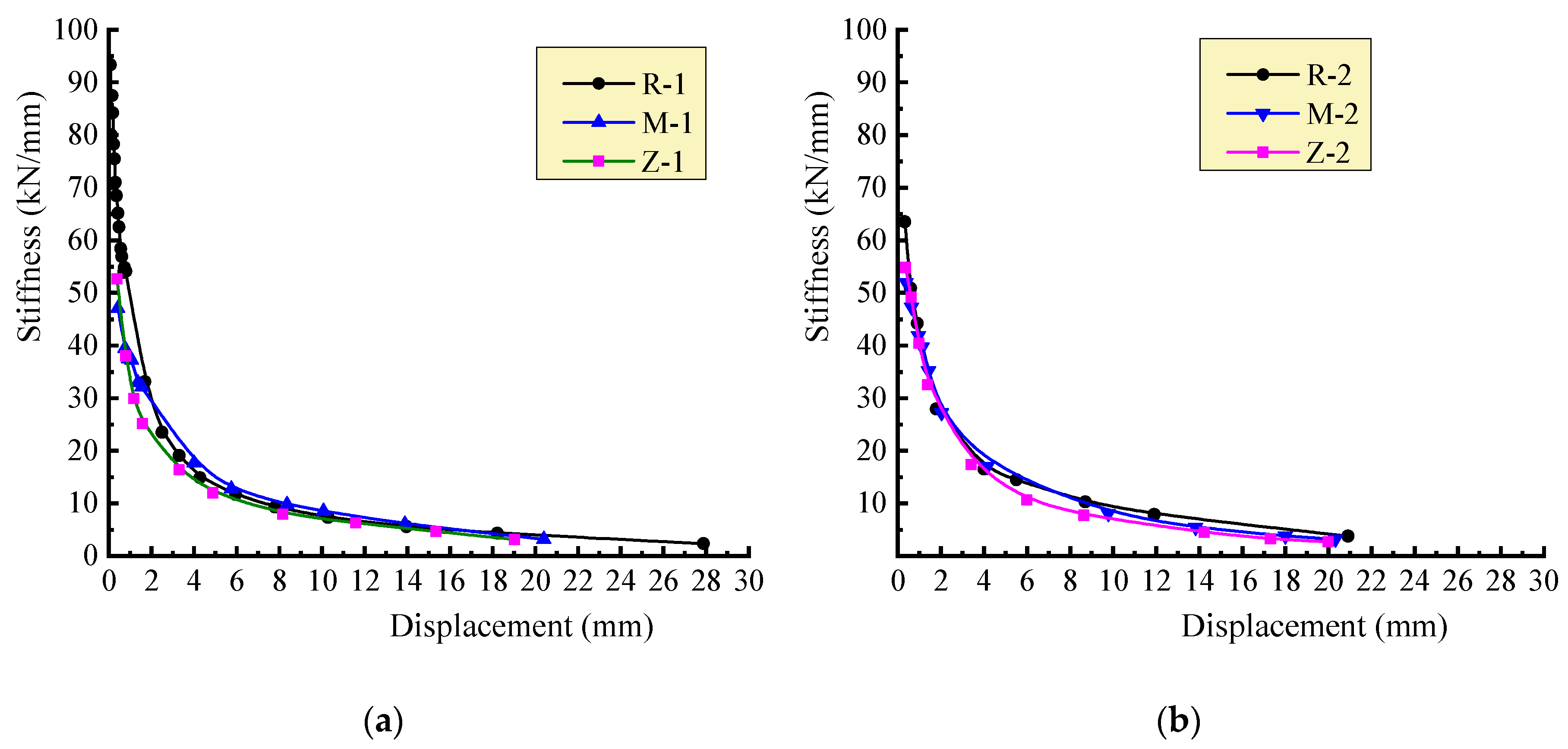
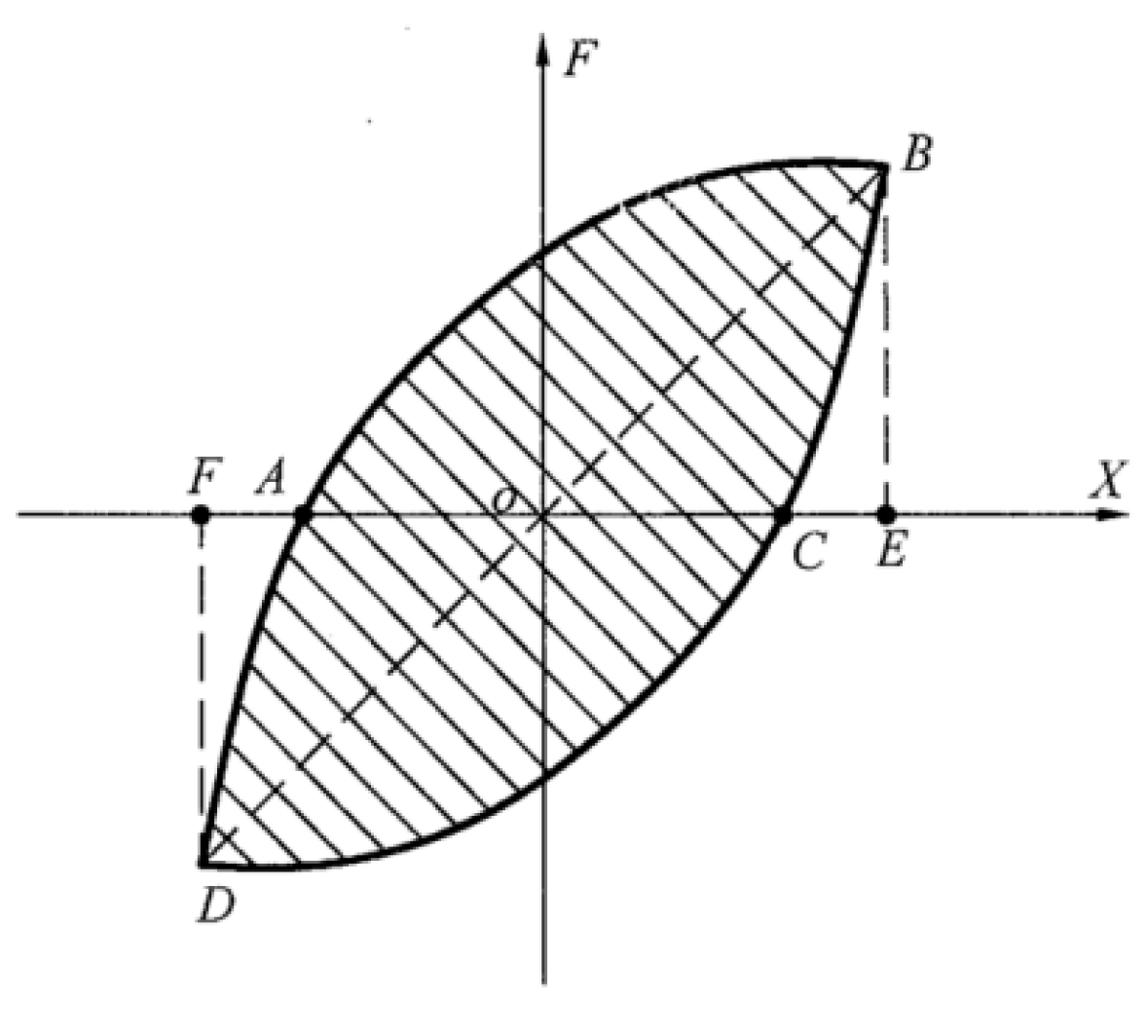
| Wall Number | Dimension (mm) | Joint Thickness (mm) | Mineral Wool Vertical Joints | Vertical Compressive Stress (MPa) | Heat Transfer Coefficient [W/(m2·K)] | ||
|---|---|---|---|---|---|---|---|
| Length | Height | Thickness | |||||
| R-1 | 1220 | 1245 | 250 | 10 | no | 0.3 | 0.541 |
| R-2 | 1230 | 1240 | 250 | 10 | no | 0.5 | 0.522 |
| M-1 | 1215 | 1220 | 250 | 5 | no | 0.3 | 0.508 |
| M-2 | 1220 | 1230 | 250 | 5 | no | 0.5 | 0.514 |
| Z-1 | 1230 | 1220 | 250 | 5 | yes | 0.3 | 0.524 |
| Z-2 | 1230 | 1225 | 250 | 5 | yes | 0.5 | 0.541 |
| Wall Number | Cracking | Ultimate | Damage | |||
|---|---|---|---|---|---|---|
| Load (kN) | Displacement (mm) | Load (kN) | Displacement (mm) | Load (kN) | Displacement (mm) | |
| R-1 | 43 | 0.82 | 72 | 19.41 | 61 | 38.91 |
| 43 | 0.77 | 87 | 14.09 | 74 | 20.51 | |
| R-2 | 50 | 1.58 | 98 | 14.36 | 83 | 16.23 |
| 50 | 2.00 | 90 | 8.25 | 77 | 26.45 | |
| M-1 | 50 | 1.75 | 81 | 10.85 | 69 | 21.02 |
| 50 | 1.36 | 90 | 9.27 | 77 | 24.67 | |
| M-2 | 55 | 1.10 | 87 | 9.42 | 74 | 20.89 |
| 55 | 2.94 | 70 | 10.12 | 60 | 21.42 | |
| Z-1 | 40 | 2.35 | 70 | 13.62 | 60 | 18.33 |
| 40 | 0.83 | 75 | 9.52 | 64 | 21.16 | |
| Z-2 | 45 | 1.33 | 57 | 7.02 | 48 | 24.18 |
| 45 | 1.44 | 77 | 7.42 | 65 | 19.54 | |
| Wall Number | Cracking | Ultimate | ||
|---|---|---|---|---|
| φ | ξeq | φ | ξeq | |
| R-1 | 1.83 | 0.29 | 1.73 | 0.27 |
| R-2 | 1.96 | 0.31 | 1.87 | 0.30 |
| M-1 | 2.24 | 0.36 | 1.80 | 0.29 |
| M-2 | 2.13 | 0.34 | 2.14 | 0.34 |
| Z-1 | 2.02 | 0.32 | 1.87 | 0.30 |
| Z-2 | 1.86 | 0.30 | 1.69 | 0.27 |
| Wall Number | Tested (MPa) | Calculated by Equations (MPa) | |||
|---|---|---|---|---|---|
| (4) | (5) | (7) | (8) | ||
| R-1 | 79.5 | 98.4 | 157.0 | 112.8 | 61.9 |
| R-2 | 94.0 | 108.4 | 156.9 | 113.8 | 61.9 |
| M-1 | 85.5 | 70.6 | 120.1 | 75.9 | 66.0 |
| M-2 | 78.5 | 80.1 | 119.3 | 76.3 | 66.4 |
| Z-1 | 72.5 | 71.5 | 121.6 | 76.9 | 66.2 |
| Z-2 | 67.0 | 80.7 | 157.1 | 76.9 | 66.4 |
© 2020 by the authors. Licensee MDPI, Basel, Switzerland. This article is an open access article distributed under the terms and conditions of the Creative Commons Attribution (CC BY) license (http://creativecommons.org/licenses/by/4.0/).
Share and Cite
Liu, Y.; Chen, G.; Wang, Z.; Chen, Z.; Gao, Y.; Li, F. On the Seismic Performance of Autoclaved Aerated Concrete Self-Insulation Block Walls. Materials 2020, 13, 2942. https://doi.org/10.3390/ma13132942
Liu Y, Chen G, Wang Z, Chen Z, Gao Y, Li F. On the Seismic Performance of Autoclaved Aerated Concrete Self-Insulation Block Walls. Materials. 2020; 13(13):2942. https://doi.org/10.3390/ma13132942
Chicago/Turabian StyleLiu, Yun, Gonglian Chen, Zhipeng Wang, Zhen Chen, Yujia Gao, and Fenglan Li. 2020. "On the Seismic Performance of Autoclaved Aerated Concrete Self-Insulation Block Walls" Materials 13, no. 13: 2942. https://doi.org/10.3390/ma13132942
APA StyleLiu, Y., Chen, G., Wang, Z., Chen, Z., Gao, Y., & Li, F. (2020). On the Seismic Performance of Autoclaved Aerated Concrete Self-Insulation Block Walls. Materials, 13(13), 2942. https://doi.org/10.3390/ma13132942





